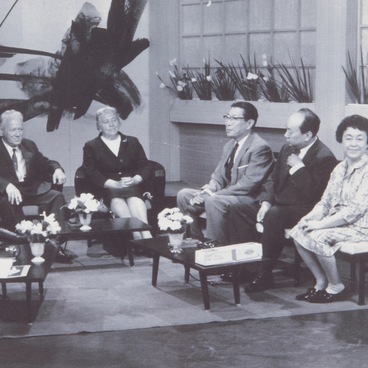This cigarette holder used to belong to the writer Mikhail Sholokhov in the 1980s.
This device is believed to improve the quality of smoke and slightly reduce the amount of harmful chemicals found in tobacco. Moreover, a cigarette holder prevents tar in cigarettes from staining the fingers and protects the smoker from the lingering smell.
A cigarette holder consists of a wider upper part with a tapered hole for a cigarette and a narrower part, the so-called mouthpiece. The upper part is a brown tip of a circular section which is attached to the main body by a connector with a sponge. The sponge is black and has an elliptical section. Above the connection is a white spot.
Cigarette holders came to Russia from Germany. This is where this unique accessory was designed. It is a slender tube in which a cigarette is held for smoking. Initially, it was aimed at saving tobacco. Back then, the smoking process was associated with several difficulties: the paper in which tobacco was wrapped could get wet, large tobacco flakes could get in the smoker’s mouth, and the smoke itself was bitter and acrid.
In 1890, the engineer Charles Peterson invented the first cigarette holder which he improved several years later. It was a device made of a small hollow tube. A person could put a roll-up cigarette inside, to make the process of smoking more pleasant.
Cigarette holders were made of various materials, including glass, wood, amber, bone, horn, ebonite, reed, and jet. There were also more basic devices made in the form of tubes with a system for pushing out cigarette butts and replaceable filters which were designed to reduce harmful elements inhaled by the smoker. Sholokhov used a simple traditional cigarette holder.
As the writer often used such devices, he had a small collection of cigarette holders. This can be proven by many of his candid photographs taken by chance. In an informal setting, Sholokhov was often portrayed with a cigarette holder in his hands.
The writer’s large office in the museum houses an item with a sad story — a holder with a cigarette that was never finished. This was one of the last things that Sholokhov touched in the last moments of his life, on the evening of February 20, 1984.
This device is believed to improve the quality of smoke and slightly reduce the amount of harmful chemicals found in tobacco. Moreover, a cigarette holder prevents tar in cigarettes from staining the fingers and protects the smoker from the lingering smell.
A cigarette holder consists of a wider upper part with a tapered hole for a cigarette and a narrower part, the so-called mouthpiece. The upper part is a brown tip of a circular section which is attached to the main body by a connector with a sponge. The sponge is black and has an elliptical section. Above the connection is a white spot.
Cigarette holders came to Russia from Germany. This is where this unique accessory was designed. It is a slender tube in which a cigarette is held for smoking. Initially, it was aimed at saving tobacco. Back then, the smoking process was associated with several difficulties: the paper in which tobacco was wrapped could get wet, large tobacco flakes could get in the smoker’s mouth, and the smoke itself was bitter and acrid.
In 1890, the engineer Charles Peterson invented the first cigarette holder which he improved several years later. It was a device made of a small hollow tube. A person could put a roll-up cigarette inside, to make the process of smoking more pleasant.
Cigarette holders were made of various materials, including glass, wood, amber, bone, horn, ebonite, reed, and jet. There were also more basic devices made in the form of tubes with a system for pushing out cigarette butts and replaceable filters which were designed to reduce harmful elements inhaled by the smoker. Sholokhov used a simple traditional cigarette holder.
As the writer often used such devices, he had a small collection of cigarette holders. This can be proven by many of his candid photographs taken by chance. In an informal setting, Sholokhov was often portrayed with a cigarette holder in his hands.
The writer’s large office in the museum houses an item with a sad story — a holder with a cigarette that was never finished. This was one of the last things that Sholokhov touched in the last moments of his life, on the evening of February 20, 1984.





